Inside The New York Botanical Garden
Posted in Learning Experiences, Wildlife on August 19 2010, by Plant Talk
See Honey Taken from Hive Saturday as Part of National Celebration
 |
Toby Adams is Manager of the Ruth Rea Howell Family Garden. |
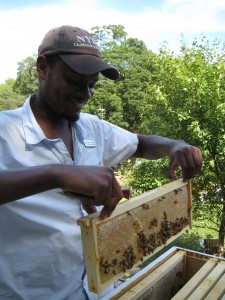 Every day during the gardening season, the Family Garden is a hive of activity hours before visitors arrive. A diverse staff—coordinators, instructors, explainers, volunteers, and interns—zip about this way and that, preparing for the day’s programs. I’ve described this scene as resembling a beehive—the many tasks to be accomplished are shared by everyone, with necessary details divided and completed.
Every day during the gardening season, the Family Garden is a hive of activity hours before visitors arrive. A diverse staff—coordinators, instructors, explainers, volunteers, and interns—zip about this way and that, preparing for the day’s programs. I’ve described this scene as resembling a beehive—the many tasks to be accomplished are shared by everyone, with necessary details divided and completed.
Veteran staff mentor new arrivals in how to get tiny seeds and delicate plantings off to a good start. Difficult projects are completed through teamwork and cooperation, and the most unglamorous but important of chores (cleaning the tools and washing the dirty dishes) taken on by a willing hand for the benefit of the group.
I’ve come to realize that this analogy to a beehive is most appropriate. Since May 1, I’ve had the awesome opportunity to witness the activity of a real beehive while helping to manage our newest addition to the Family Garden—two honeybee hives placed on top of our garage.
Read More
Posted in Exhibitions, The Edible Garden on August 18 2010, by Plant Talk
How Hot Can You Tolerate? Visit Trial Bed in Home Gardening Center
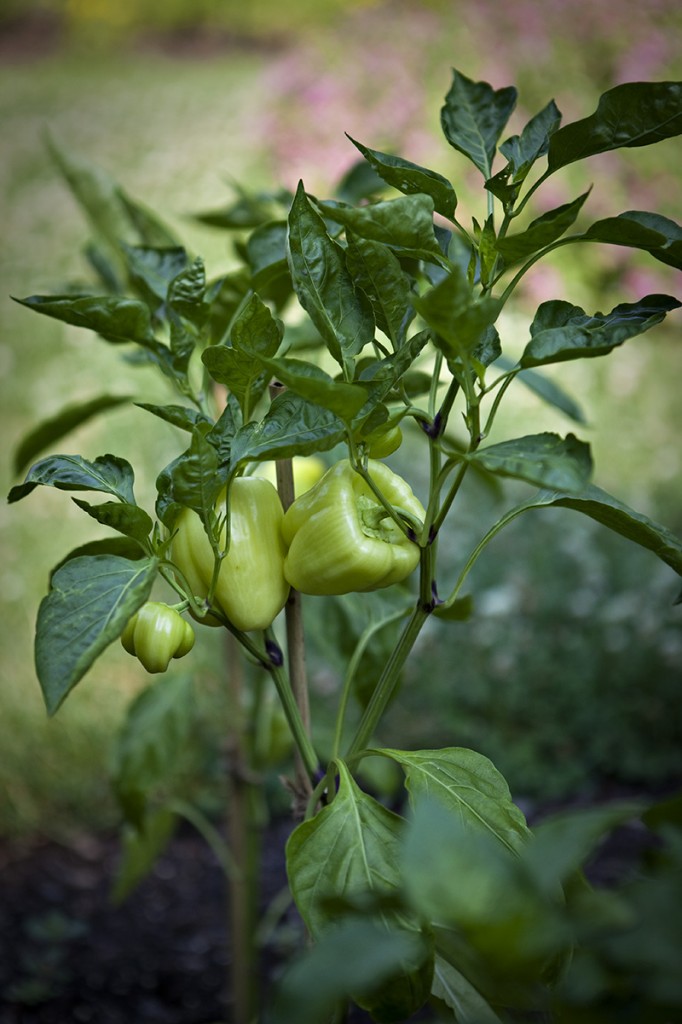 Some might say this summer’s weather has been hotter than a chili pepper. But there are some really intense chili peppers out there! During The Edible Garden, the Home Gardening Center is featuring a Chili Pepper Trial Bed, highlighting 48 plants of 12 cultivars in a range of colors, sizes, and heat intensity.
Some might say this summer’s weather has been hotter than a chili pepper. But there are some really intense chili peppers out there! During The Edible Garden, the Home Gardening Center is featuring a Chili Pepper Trial Bed, highlighting 48 plants of 12 cultivars in a range of colors, sizes, and heat intensity.
The chili pepper is thought to be the most popular spice: Over 20 percent of the world’s population uses it in some form. Famous for a hot flavor, there are many different cultivated types, each with distinct characteristics.
The term chili pepper is used for several of the nearly 25 species in the genus Capsicum, all of which originated in Central and South America. The two most common species are Capsicum annuum and Capsicum frutescens.
The level of the pungent compound capsaicin is what accounts for the pungency or heat in chilies. Some peppers are so pungent that farmers and cooks need to wear gloves to protect their skin, which can become irritated or blistered just by touching the peppers.
The hotness of a chili pepper is measured in Scoville Heat Units, named after the U.S. pharmacologist Wilbur Scoville who in 1912 invented a hotness gauge. On the Scoville scale, a sweet pepper scores 0, a jalapeño pepper around 3,000, and a Mexican habañero a scorching 500,000.
The Chili Pepper Trial Bed is arranged according to the Scoville scale and includes Capsicum chinese ‘Bhut Jolokia’ from India, which registers over 1 million Scoville units! Labels in the garden indicate how hot each pepper is.
Come visit the trial bed and The Edible Garden to get ideas on which types you’d like to try—in your garden and in your cooking. On Saturday, September 25, we’ll present a home gardening demonstration on chili peppers, Some Like It Hot, as part of the Fiesta de Flores y Comida festival weekend, celebrating Hispanic Heritage Month with flowers, food, dancing, cooking demonstrations (with Chef Maricel Presilla and others), and more.
Get Your Tickets
Posted in Science on August 17 2010, by Plant Talk
View the Diversity, Distribution, and Status of 45 Species
 |
Brian M. Boom, Ph.D., is Director of the Caribbean Biodiversity Program at The New York Botanical Garden.
|
 Regular readers of Plant Talk may recall the post I co-wrote during The Orchid Show: Cuba in Flower in March that highlighted the long history and current program of plant exploration in Cuba by scientists of The New York Botanical Garden. Orchids are one of the most diverse of flowering plant families in Cuba, where some 497 species and varieties are known, of which about 181 (36%) are endemic to the island.
Regular readers of Plant Talk may recall the post I co-wrote during The Orchid Show: Cuba in Flower in March that highlighted the long history and current program of plant exploration in Cuba by scientists of The New York Botanical Garden. Orchids are one of the most diverse of flowering plant families in Cuba, where some 497 species and varieties are known, of which about 181 (36%) are endemic to the island.
Cuban botanists presently consider that at least 32 species of orchids are threatened due to various factors such as habitat modification and climate change. However, the process of evaluating at-risk species in Cuba, and elsewhere, is far from complete. The Botanical Garden is currently developing a new method to evaluate at-risk species much more rapidly than has been done traditionally so that we can get a more complete view of the status of plants in Cuba and throughout the Caribbean. (See page 6 of Garden News.)
Read More
Posted in Gardening Tips on August 16 2010, by Sonia Uyterhoeven
 |
Sonia Uyterhoeven is Gardener for Public Education. Join her each weekend for home gardening demonstrations on a variety of topics in the Home Gardening Center. |
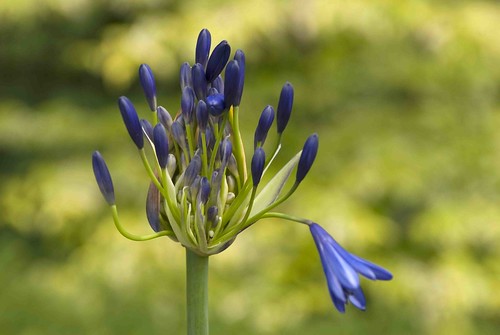 Those of you who have visited the Garden this year will have noticed the large containers of brilliant blue agapanthus or African lily that decorate the entrance to the Garden Cafe. (The cultivar we are growing this year is ‘Storm Cloud’.)
Those of you who have visited the Garden this year will have noticed the large containers of brilliant blue agapanthus or African lily that decorate the entrance to the Garden Cafe. (The cultivar we are growing this year is ‘Storm Cloud’.)
Agapanthus is hardy from zones 7 or 8 to zone 10. Some of the many species are evergreen, others deciduous; the deciduous species tend to be hardier and benefit from a heavy winter mulch.
The good news for those of you living outside the hardiness zones is that agapanthus love to grow in a pot and don’t mind crowded quarters. In this part of the country, the easiest thing to do in winter is to store the container of agapanthus in a cool basement or garage, and keep the plants from drying out.
Read More
Posted in Exhibitions, The Edible Garden on August 13 2010, by Plant Talk
Anything Goes—and Grows—in Potting Up Vegetables for Small Spaces
 |
Francisca Coelho is the Vivian and Edward Merrin Associate Vice President for Glasshouses and Exhibitions. |
 You may not be aware of this, but every plant you have grown in a pot, box, can, tub, or other vessel is an example of container gardening. Your potted houseplants, summer pots of annuals, and hanging baskets all represent gardening in containers. In the tropics where I grew up, people lined their front steps with many colorful, painted containers of every shape and size. They filled them with beautiful, tropical, flowering exotics and with plants used for food and medicine. Versatility is the hallmark of the container gardener!
You may not be aware of this, but every plant you have grown in a pot, box, can, tub, or other vessel is an example of container gardening. Your potted houseplants, summer pots of annuals, and hanging baskets all represent gardening in containers. In the tropics where I grew up, people lined their front steps with many colorful, painted containers of every shape and size. They filled them with beautiful, tropical, flowering exotics and with plants used for food and medicine. Versatility is the hallmark of the container gardener!
In front of the Enid A. Haupt Conservatory, as part of The Edible Garden, I am growing an assortment of tasty vegetables in containers. The design is simple-a mix of semicircles and straight lines with pots ranging in size from 14 to 36 inches in diameter.
The steps leading up to the elevated area are lined with pots filled with Tumbling Tom tomatoes, mammoth red cabbages, purple kohlrabi and kale, ornamental trailing sweet potato vines, and marigolds, included to ward off unwelcomed pests and to encourage hungry bees to pollinate my edible delights.
Read More
Posted in Exhibitions, The Edible Garden on August 11 2010, by Plant Talk
What Do These Have to Do with Helping Solve the Climate Crisis?
 |
Anna Lappé is author of Diet for a Hot Planet: The Climate Crisis at the End of Your Fork and What You Can Do About. She will give a talk at the Garden as part of The Edible Garden’s Food for Thought series on August 19 at 7 p.m. |
 A few nights ago, I watched the sky darken over the East River while I listened to clucking chickens peacefully pecking on the roof of a loft in Greenpoint, Brooklyn. Eagle Street Rooftop Farm is just one of the rooftop farms sprouting up across the city, bringing to communities fresh food and the opportunity to get our hands in the dirt.
A few nights ago, I watched the sky darken over the East River while I listened to clucking chickens peacefully pecking on the roof of a loft in Greenpoint, Brooklyn. Eagle Street Rooftop Farm is just one of the rooftop farms sprouting up across the city, bringing to communities fresh food and the opportunity to get our hands in the dirt.
Eagle Street, all 6,000 square feet of it, has only been around two growing seasons, but it already boasts a loyal following. A dozen families are members of its CSA; hundreds of kids have munched on its peppers and tomatoes; and from 40 to 65 volunteers a week have dug in its raised beds. The place is buzzing with life and, the day I was there, newborn rabbits, who earn their keep with droppings used for fertilizer.
Eagle Street is just one of the reasons I’m not feeling so blue these days. In the face of mounting environmental catastrophes—from global climate change to a dead zone in the Gulf of Mexico that swells to the size of New Jersey every year—there’s a lot to feel depressed about. These crises can feel far removed from our daily lives and from our control. But with every choice we make about where get our food, how we support sustainable solutions in our cities, we are helping to heal the climate.
Read More
Posted in Exhibitions, The Edible Garden on August 10 2010, by Plant Talk
Written by Burpee Home Gardens Team. Burpee Home Gardens is a Supporting Sponsor of The Edible Garden.
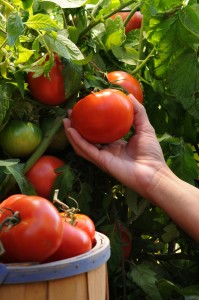 Harvest time is an exciting time in the garden. Those plants you have been taking care of, feeding, weeding, and watering are now returning the favor with ripe pickings for you to enjoy. Very quickly you’ll have a kitchen counter or bushel filled with red and juicy tomatoes, tasty peppers, flavorful cucumbers, and more.
Harvest time is an exciting time in the garden. Those plants you have been taking care of, feeding, weeding, and watering are now returning the favor with ripe pickings for you to enjoy. Very quickly you’ll have a kitchen counter or bushel filled with red and juicy tomatoes, tasty peppers, flavorful cucumbers, and more.
What to do with all this plenty—and when—present some of the last obstacles of the season for new vegetable gardeners. If you’re suddenly inundated with abundance, here are a few tips to remember to receive maximum flavor from your harvest:
Read More
Posted in Gardening Tips on August 9 2010, by Sonia Uyterhoeven
 |
Sonia Uyterhoeven is Gardener for Public Education. Join her each weekend for home gardening demonstrations on a variety of topics in the Home Gardening Center. |
 While it is edifying to talk about ways to reduce the need for supplemental irrigation as I did last week in my blog post that explored drought-tolerant plants, it is all water under the bridge if the beautiful xeric garden that is planted isn’t properly maintained.
While it is edifying to talk about ways to reduce the need for supplemental irrigation as I did last week in my blog post that explored drought-tolerant plants, it is all water under the bridge if the beautiful xeric garden that is planted isn’t properly maintained.
Here are some tips to get you going in the right direction. Many of the suggestions are common sense, but I am generally so anxious to get the plants in the ground and to watch them start growing, that I often need these reminders myself.
Read More
Posted in Exhibitions, The Edible Garden on August 6 2010, by Plant Talk
Presenting Chef Muses on Creating Dishes with Tomatoes
 |
Heather Carlucci-Rodriguez is Pastry Chef at Print Restaurant in Manhattan. She will present cooking demonstrations at The Edible Garden Conservatory Kitchen on August 8 at 1 and 3 p.m. |
 I really don’t think I could have gotten a better item than the tomato (the food selected as the theme of the weekend at The Edible Garden). I’d probably say that about corn if I had been given that as a topic to demo. But honestly, it leaves the whole world open for talk, cooking, pairing, art—you name it.
I really don’t think I could have gotten a better item than the tomato (the food selected as the theme of the weekend at The Edible Garden). I’d probably say that about corn if I had been given that as a topic to demo. But honestly, it leaves the whole world open for talk, cooking, pairing, art—you name it.
I grew up in the neighborhoods around The New York Botanical Garden, and I’m witness to the fact that, lucky for me, the tomato grows bountifully everywhere.
Being a pastry chef, I thought about doing something sweet for my August 8 demo…for about a minute. I am a complete pushover for anything savory with tomatoes. And the tomato is so perfect as it is. Adding sugar, as intriguing as it is, is so unnecessary. Sauces, salads, soups, by itself with a little salt and olive oil…It’s versatile and perfect at this time of year. A must in most of the mother cuisines. The best carrier of the flavor of herbs, vinegars.
Read More
Posted in Exhibitions, The Edible Garden on August 5 2010, by Plant Talk
Spend a Summer Evening with Music, Wine, Cheese, and More
 I always enjoy a great concert in the summer, especially in one of New York City’s fabulous outdoor spaces. There is something just so civilized about hearing great music in exceptional garden surroundings.
I always enjoy a great concert in the summer, especially in one of New York City’s fabulous outdoor spaces. There is something just so civilized about hearing great music in exceptional garden surroundings.
I usually find, however, that I need to bring something to eat and to drink. Well, not at The New York Botanical Garden. We have thought of everything.
During the Waterlily Concert Series at the Garden, which begins this evening and continues on August 12 and 19, Abigail Kirsch is ready to cater to your needs. We are featuring picnic baskets with beer or wine, cheese, crudités, and fruit—a perfect accompaniment to a wonderful summer evening. Other refreshments will be available as well: sandwiches, a variety of snacks, non-alcoholic beverages, and cookies and desserts.
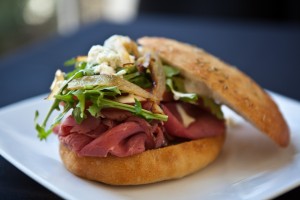 Before each performance, visitors can view The Edible Garden with its Celebrity Chef Kitchen Gardens, Martha Stewart Culinary Herb Garden, and more, and then hear commentary about the importance of food choices in our lives during Food for Thought presentations.
Before each performance, visitors can view The Edible Garden with its Celebrity Chef Kitchen Gardens, Martha Stewart Culinary Herb Garden, and more, and then hear commentary about the importance of food choices in our lives during Food for Thought presentations.
Although seating is provided rain or shine under the tent at the Conservatory Kitchen stage where the lectures and music will be held, I encourage you to bring a blanket to enhance your experience. Stretch out under the sky while enjoying sumptuous fare and listening to fabulous music. There’s no better way to beat the summer heat!
See who’s presenting and performing.
Get Your Tickets

 Every day during the gardening season, the Family Garden is a hive of activity hours before visitors arrive. A diverse staff—coordinators, instructors, explainers, volunteers, and interns—zip about this way and that, preparing for the day’s programs. I’ve described this scene as resembling a beehive—the many tasks to be accomplished are shared by everyone, with necessary details divided and completed.
Every day during the gardening season, the Family Garden is a hive of activity hours before visitors arrive. A diverse staff—coordinators, instructors, explainers, volunteers, and interns—zip about this way and that, preparing for the day’s programs. I’ve described this scene as resembling a beehive—the many tasks to be accomplished are shared by everyone, with necessary details divided and completed.















